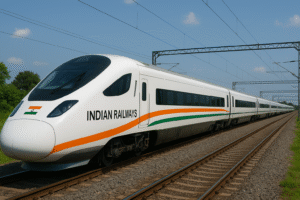India’s First Bullet Train: Inside the Mumbai–Ahmedabad High-Speed Rail Project
Mumbai–Ahmedabad Bullet Train Project: A Leap Toward India’s High-Speed Future
India’s first bullet train corridor between Mumbai and Ahmedabad is rapidly transforming into a reality. Spanning 508 kilometers, the project is one of the largest infrastructure undertakings in the country, combining cutting-edge Japanese technology with Indian engineering expertise.
The corridor includes 465 kilometers of viaducts, 25 river bridges, 28 steel bridges, a 21-kilometer tunnel, eight mountain tunnels, 12 modern stations, and three rolling stock depots. To accelerate viaduct construction, engineers are using the Full Span Girder Launching Technique — deployed for the first time in India. This innovative method is ten times faster than traditional approaches. Each girder measures 40 meters in length, weighs around 970 metric tons, and is precisely lifted into position using a 1,100-ton capacity launching gantry. As a result, a 40-meter-long bridge section can be completed in just 16 hours.
As of now, nearly 323 kilometers of viaduct have been constructed, with more than 400,000 noise barriers installed on both sides. Overhead electrification masts have also been erected along 53 route kilometers.
Advanced Track and Construction Technology
The project marks the debut of the J-Slab ballastless track system in India. Every stage of track installation is fully mechanized and executed using Japanese-designed machinery. So far, 105 route kilometers of reinforced concrete track beds have been laid, and 9 route kilometers of track slabs have been installed and grouted. The first turnout crossing near Surat Bullet Train Station has also been completed.
More than 1,000 Indian engineers and technicians are receiving specialized training and certification from JARTS — Japan’s leading agency for railway technology education — in various disciplines related to track installation and testing.
Bridges and Tunnels: Engineering Marvels
Construction of bridges across 25 rivers is progressing quickly, with 17 already completed. Similarly, 28 steel bridges are being built to cross highways, expressways, and railway lines, of which nine are finished. The fabrication of these massive steel structures is taking place in six workshops across India, using approximately 65,000 metric tons of high-grade steel.
Equally impressive are the eight mountain tunnels being developed using the New Austrian Tunneling Method (NATM). The highlight of this segment is the 21-kilometer-long Mumbai–Thane tunnel, including a 7-kilometer undersea stretch beneath Thane Creek — India’s first undersea rail tunnel. Connecting Mumbai’s Bandra Kurla Complex (BKC) to Shilphata in Thane, this section uses both NATM and Tunnel Boring Machine (TBM) techniques. The TBM employed here features the largest cutter head ever used in an Indian rail project, measuring 13.6 meters in diameter.
State-of-the-Art Stations and Depots
To meet the project’s ambitious timelines, multiple construction facilities have been established, including casting yards, noise barrier factories, track slab production sites, and tunnel lining segment yards. Three major rolling stock depots are also under rapid development.
Each of the 12 planned bullet train stations is being designed to reflect the local culture and architecture of its city while incorporating world-class passenger facilities and smart technologies. The underground station at BKC in Mumbai stands out — located 32 meters below ground, equivalent to a 10-story building, and topped by a 90-meter-high superstructure housing offices, residences, and retail spaces.
Meanwhile, the multimodal transit hub at Sabarmati — inspired by the Dandi March movement — is already complete. It will seamlessly connect the bullet train network with Western Railway services, the city metro, and the BRTS corridor.
A Symbol of Indo-Japanese Collaboration
Driven by Japan’s technological mastery and India’s forward-looking vision, the Mumbai–Ahmedabad High-Speed Rail Corridor is more than an infrastructure project. It’s a symbol of innovation, trust, and international cooperation — a project poised to redefine travel in India and usher in a new era of speed, safety, and connectivity for millions.

